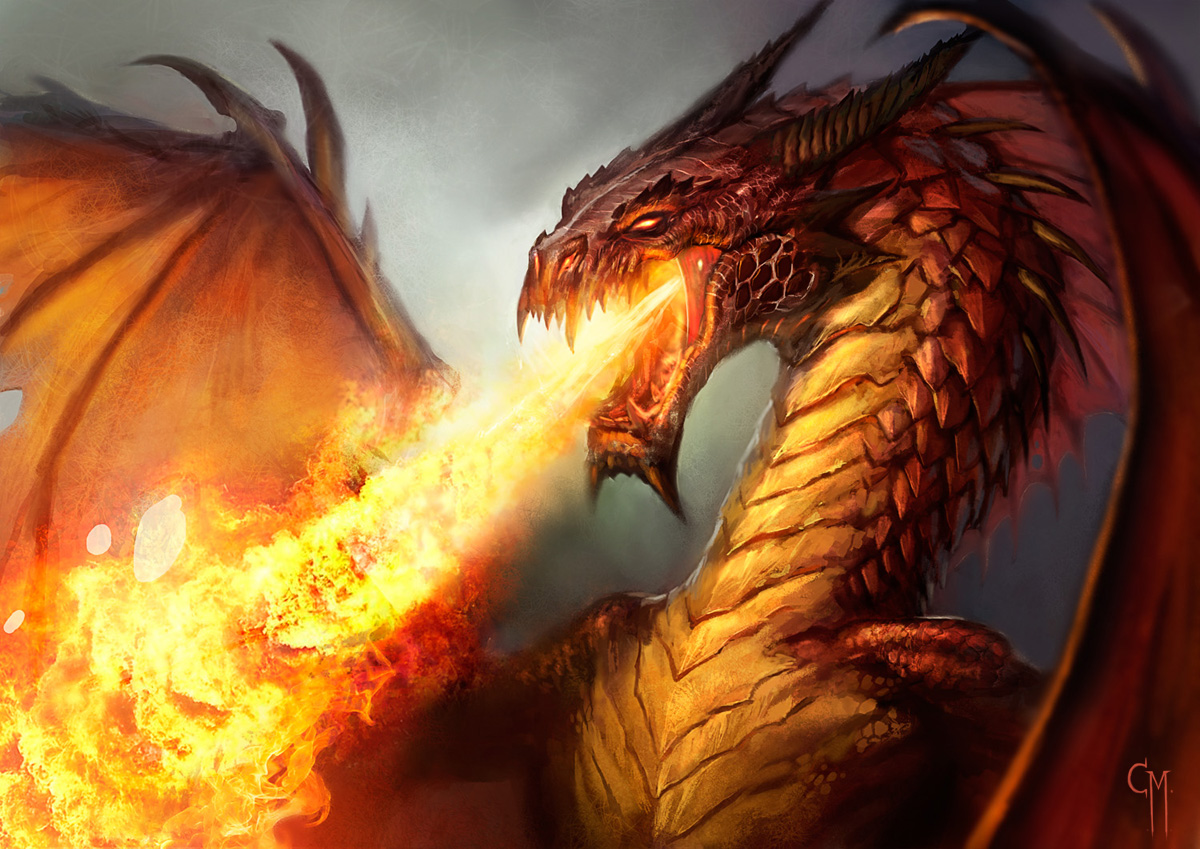
The Meaning of Dragons
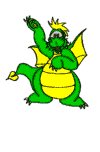
Welcome to the Hidden Meaning page.
By clicking on the parchment scroll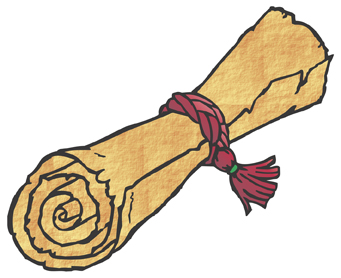 you have portal-jumped to a hidden meaning page. you have portal-jumped to a hidden meaning page.
Language translator at bottom in the footer.

Riding the dragon by Gustave Dore (19th c.)
(symbolic meaning: Riding the Dragon= Caught up in ones darker aspects [i.e. ones emotional demons], or alternatively it means freedom, independence and leaving the expectations and stresses of the every day. In this case it could also be symbolic of the feminine dominating the masculine.)
Symbolic meaning of the Dragon in dreams:
The dragon and the snake have a rich symbolic history in the mythology of mankind. In general, animals were seen to have certain attributes that were often observed in their natural behaviors. It was these attributes that people wanted to take on for themselves and it was thought that aligning ones self, or by extension, ones nation, or tribe with the animal it would assist in this process. This practice still exist to some extent in military banners and national emblems, note the Eagle in the Marine Corps banner as well as that of the national emblem, or the the double headed eagle of Greece or the eagle in the egyptian flag, or the dragon in the flag of Wales.
•The Dragon is often the protector of treasure with the TREASURE representing YOU. It can represent fears that have to be overcome before recognizing the true self. Often it can be the guardian of the spirit. For some it is their 'Spirit Guide.' But what is it that the Dragon protects? Get some insight by jumping to this page 
•It is a primal force of nature (see Aborigine reference below).
•It may also represent an emotional pattern in that it may symbolize you being controlled by your passions or it could be linked to a fiery, hot temper, or being angry. It may also say something about your sexual drive.
•In order to defeat the beast within one needs to show the selfless courage of a hero/heroine such as St. George the dragon slayer, or St Joan d'Arc whose guide and protector in her dreams was the dragon slayer St. Michael.
•The St George and the Dragon motif shows up in many cultures. There is an earlier pre-christian Hitite myth about the battle between the Storm God, Tarhun and the Dragon, Illuyankus. There are Babylonian, Indo-European (Vedic), Norse, and Greek myths representing similar themes. All suggest the conquest of good over evil. Some suggest that this epic struggle is actually an attempt by the psyche to integrate the opposites and that the conquest is when one has successfully done so.
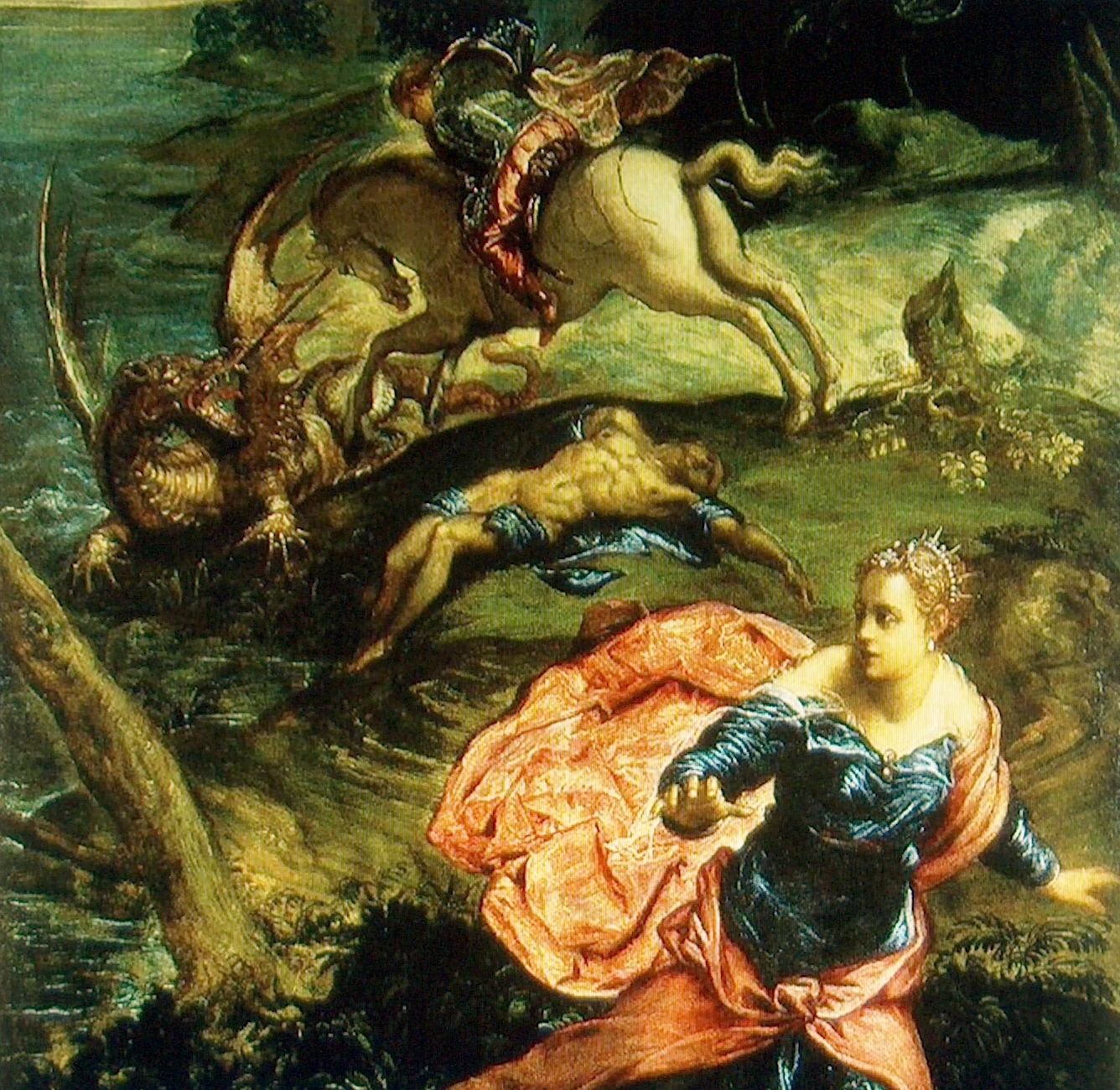
In paintings such as the one done by Jacopo Tintoretto (1560) there is also a Christ-like figure recently slain by the dragon suggesting a power play for the soul.
Click to enlarge
The symbol of conquering evil can be read in the 5th century epic poem, "Beowolf." Where the hero of that name defeats a ferocious dragon by the name of Grendel. Note that this tale is post Christian, therefor the dragon symbol takes on the "evil" characteristic.
But as you will see throughout this monograph dragons are not always seen as evil. Frequently dragons have combined characteristics such as with the four elements, earth, air, fire , and water. They often symbolize the opposites; light and dark, masculine and feminine. In the Christian tradition anything that is opposite what it determines to be good is automatically evil. As you will see both on this website and in the book The Dragon's Treasure this narrow definition makes it difficult for one to reconcile their inner opposites and then to integrate them into being a fully actualized human being( see the Individuation Process on this site). It is the unity beneath these opposites that is the realm of the dragon.
Just as man and beast figures like the Harpy (part female and part vulture) and the Minotaur (a bull's head and a man's body) represents mankind's animal nature, stories of the mastery of this nature are rife within mythology. For example there is the story of St. Gerome who removes a thorn from the paw of a lion and the lion renounces his ferocity and lies down at the foot of the saint or the earlier story of Androcles in the Aesops fable. These stories symbolize mastery, or the taming of one's animal nature not the conquering, or destruction of it. This mastery is in a way the essence of individuation.
Ancient cartographers would sometimes depict a drago, with the phrase "Here there be dragons" (hic sunt dracones) where there was no knowledge of what existed. This would be a warning to sailors that this is dangerous unexplored territory, and was often map shorthand for "Here Be Other Stuff We Don't Quite Know About." At this time the Lenox Globe seems to be the only only map where this is found.
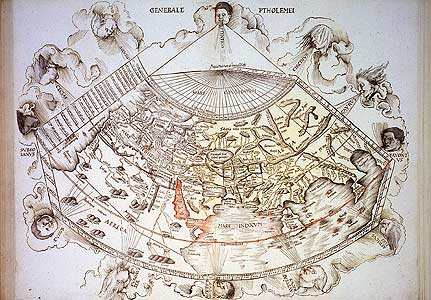
The phrase "Here Be Dragons" (or hic sunt dracones) appears on maps such as the Lenox Globe (from early 1500s) and is now considered to be a warning of unknown dangers, rather than a claim to have seen a fire-breathing monster.
 •Fighting a dragon (or any monster) may be about your inner search or quest or wanting to tame the beast within. From a Jungian perspective this may be about the ego's struggle to lift oneself from unconsciousness and to establish some control over it. Jung saw it as part of the Individuation process, the integration of ego and soul. The dragon can also represent The Great Mother archetype—the overbearing aspect (Freud suggested that it is the devouring aspect of the mother); fighting it would be an attempt to break away and to become independent from parental authority (e.g. political, economical, philosophical, societal, theological, or personal) controls. •Fighting a dragon (or any monster) may be about your inner search or quest or wanting to tame the beast within. From a Jungian perspective this may be about the ego's struggle to lift oneself from unconsciousness and to establish some control over it. Jung saw it as part of the Individuation process, the integration of ego and soul. The dragon can also represent The Great Mother archetype—the overbearing aspect (Freud suggested that it is the devouring aspect of the mother); fighting it would be an attempt to break away and to become independent from parental authority (e.g. political, economical, philosophical, societal, theological, or personal) controls.
In several paintings of archetypal heroes battling dragons there is a damsel who is to be saved. Often she represents the anima, the feminine energy in a man that needs to be protected in order to balance the overarching masculinity of the hero—too much of the masculine is not a good thing, just as is too much of the feminine. (See the anima/animus in the Archetype section under the Dream Dictionary.
Often the hero needs to confront his shadow, the darkness of the inside of the monster (as in Jonah and the whale) in order to be at one with it and assimilate its balancing power in order to have the necessary energy to defeat the monster. Sometimes the hero in a dream needs to die to what he has been in order to be reborn into what he can be. Some battles with the dragon can represent this through defeat and the death of the hero.
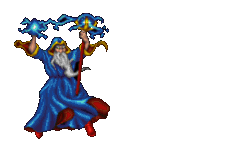 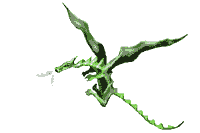
Wizards also battle dragons in our folklore. The wizard can represent the Wise Old Man Archetype who represents rational wisdom while the dragon could represent our basal selves—the lower-brain self—the primitive versus the enlightened. It represents the eternal battle between man's animal and intellectual self—between his body and soul.
•Being attacked by a Dragon (or snake) may mean you are being assaulted by your own basal impulses, or the fear of tapping into your unconscious e.g. the unknown, or what you fear is there.
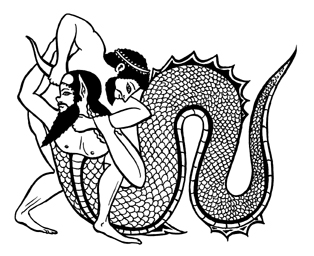 •The fearsomeness of the Dragon could represent the fear felt regarding the unconscious. •The fearsomeness of the Dragon could represent the fear felt regarding the unconscious.
•Dragon totems in some Native American traditions represent messengers of balance. They are also seen as the masters of all the elements: earth, wind, fire, and water. They are seen as powerful guardians and guides and embody the primordial power.
"A Dragon totem is one of the most powerful totems, representing a huge range of qualities, emotions, and traits. When Dragons come to us, it could mean many things.
The most common message a Dragon totem [may] carry to us is a need for strength, courage, and fortitude. Dragons are also messengers of balance, and magic - encouraging us to tap into our psychic nature and see the world through the eyes of mystery and wonder.
More specifically, Dragons are the embodiment of primordial power - the ultimate ruler of all the elements. This is because the Dragon is the master of all the elements: Fire, Water, Earth, and Wind.
As a totem, the Dragon serves as a powerful guardian and guide. Encourage communication with your Dragon, and acknowledge your Dragon's presence as often as possible."
Excerpted from:http://www.whats-your-sign.com/dragon-totem.html
With the Native Americans of the North and Southwest there were a number of Dragon and serpent legends. Most of these Dragons and serpents stole children and were associated with water. Some stories may have been used to scare children away from water and thus the serpent became a type of bogey.
Examples: Amhuluk (Oregon); Ancient Serpent (Piute); Angont (Huron); Kolowisi (Zuni); Msi-Kinepeikwa (Shawnee); Palulukon (Hopi weather Dragon-similar to Chinese version); Stvkwvnaya (Seminole Dragon with a magic horn on its head).
•The Australian Aborigine speaks of the Dreaming where two Serpents Yingara and Ngalyod (mother and father deities) are revered as the Rainbow Serpent creators of the world.
•From the Wiccan perspective the dragon represents a person of power and if in the dream you are riding on it, then it may be about spiritual insight.
•A winged Dragon may also mean some kind of transcendence, a passing from a "lower" to "higher" level of maturity or understanding.
•A Hydra is a many headed dragon. Legend has it that Hercules kept cutting off 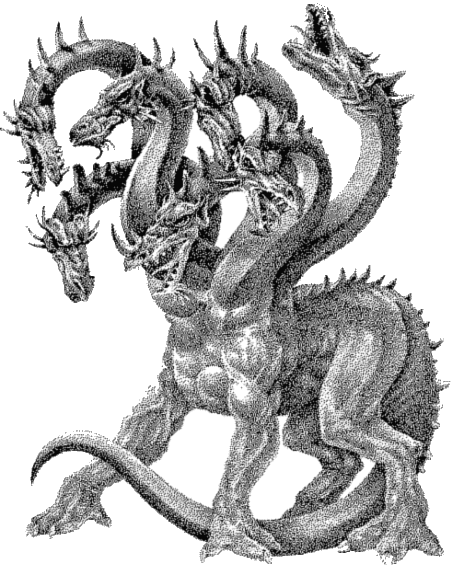 the heads, but they grew back. To dream of a hydra might suggest that you are having a recurring issue in your life i.e. something that keeps coming back and never seems to get handled. Some sources (http://en.wikipedia.org/wiki/Snap-dragon_%28game%29) suggest that after Hercules killed the dragon he made of it a flaming meat and named it "Snapdragon." A game of this name was played by children in some english speaking countries from the 16th through the late 19th centuries on both Christmas eve and All Hallows eve. In a bowl of blue flaming brandy were placed raisins that the children would try to pluck out without getting burned and then eat, all the while chanting, the heads, but they grew back. To dream of a hydra might suggest that you are having a recurring issue in your life i.e. something that keeps coming back and never seems to get handled. Some sources (http://en.wikipedia.org/wiki/Snap-dragon_%28game%29) suggest that after Hercules killed the dragon he made of it a flaming meat and named it "Snapdragon." A game of this name was played by children in some english speaking countries from the 16th through the late 19th centuries on both Christmas eve and All Hallows eve. In a bowl of blue flaming brandy were placed raisins that the children would try to pluck out without getting burned and then eat, all the while chanting,
"With his blue and lapping tongue,
many of you will be stung
Snip, snap, dragon."
The symbolism of conquering danger in both the legend of Hercules and the dragon and in the playing of the game, "Snapdragon" is inescapeable. We humans are always telling the story of conquering evil, of being the heroes of our own stories. Thus continues the ongoing reconciliation between the opposites good and evil.
•As with some other animal symbols the Dragon and/or snake may also represent your sexuality, especially if your sexuality scares you. Does it threaten to rule your life?

•Chinese mythology saw the dragon as a symbol of wisdom.
Confucious compared Lao Tzu (the writer of the Tao Te Ching) to a Dragon.
A good luck and wisdom symbol. Many pictures show the dragon handing the "Pearl of Wisdom", or the "Pearl of Potentiality"to a shaman. Good, life-giving energy (chi) is channeled along "Dragon-lines" that in China were said to follow underground water or magnetic fields.To dream of a dragon is considered by some Chinese to be very auspicious.
The Lung dragon was the most powerful of the three species of Chinese Dragon and was considered a divine animal. The Cha-yü dragon only showed up when a ruling sovereign showed a lack of virtue. This dragon was known for eating men (symbolic of an leader who consumed the virtue and life force of others).
In Chinese mythology the Dragon of Hidden Treasures is a symbol of vigilance and the guardian of their fortune.
The Chinese New Years Dragon represents benevolence , but also power, representing the forces of nature. It is a rain bringer and dragon of fertility that brings only benefit to the people.
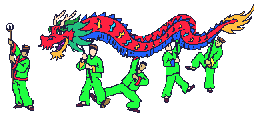
The Chinese frequently paired the dragon with the image of a phoenix bird (Fenghuang, or the August Rooster). Since Neolithic China these two were considered two of the four Supernatural Spirits symbolizing both the four directions and the four seasons (which seem to have been added to over the millennia e.g. The dragon, phoenix (or the Feng bird for short), unicorn (or deer), tortoise and tiger). They were often thought of as the "Gentleman and the Sage" and given that the Emperors of China often thought of themselves as descended from the Dragon, the Phoenix was often seen as his mate. Thus this pairing has been likened to the union of the Yin and Yang. An old saying in China goes, "When the Dragon soars and the Phoenix dances, the people will enjoy happiness for years..."
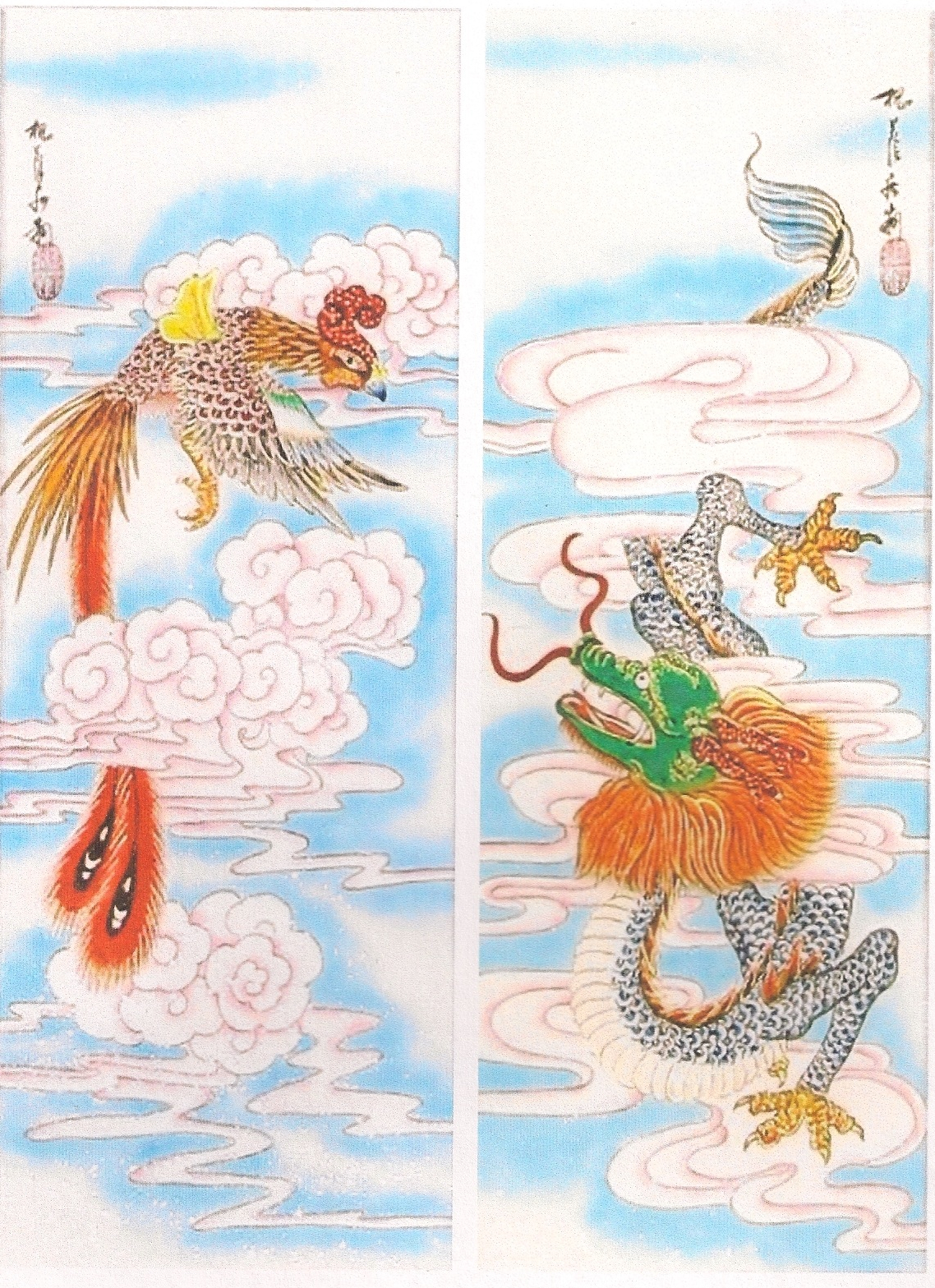
As per Chineseartstore.com
For the ancient Chinese culture dragons were primarily symbolic, but the idea of the actual existence of Dragons surfaced Millennia ago as the philosopher Chang Qu found gigantic bones of a dinosaur and mistook them for that of a dragon.
In Chinese myth, dragons originated as rain deities. Folk legends say that the dragon lives under water half of the year, rising into the sky during the spring when the constellation of Draco, the dragon, is at its highest. In China, dragons are symbols of authority, fertility, goodness and strength, and the benevolent giver of wealth and good fortune.
They were generally portrayed as protectors, guarding treasure, temples, or even Heaven itself, keeping watch over sky and waterways. This image of beneficent power was appreciated by China's rulers, who used the dragon as an imperial symbol. The emperor occupied the Dragon Throne, wore dragon robes and even slept in the dragon bed. Chinese people sometimes referred to themselves as children of the dragon.
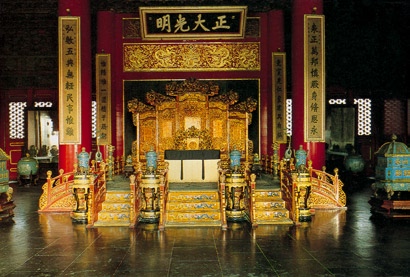 The Dragon Throne, The Forbidden City, Bejing. The Dragon Throne, The Forbidden City, Bejing.
In Chinese culture, the season of the Dragon is mid-spring, its direction is east by southeast, and its fixed element is wood.
The myth of the Dragon and the Fairy is the creation myth of Vietnam where the son of a dragon and the daughter of a fairy were married and she produced a hundred eggs that became the first 100 Vietnamese. In this story the Dragon represents the Yang, or male, energy, while the fairy represents the Yin, or feminine energy and it is that union that brings life. Thus the Vietnamese are "Con Rồng, cháu Tiên" (the children of the dragon, the grandchildren of god).
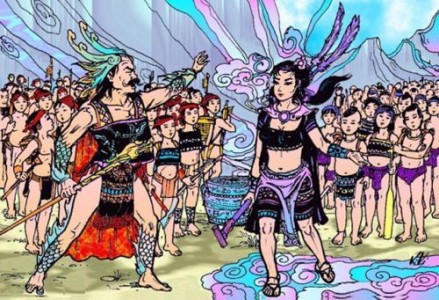
The Vietnamese creation story "The Dragon and the Fairy
A typical Vietnamese dipiction of the dragon is shaped like the country of Vietnam with the head in the north and the tail in the south.
In Vietnam, Korea, and China the dragon is related to water, rain and agriculture.
In Bhutan the dragon is the Druk. The country is the land of the Druk.
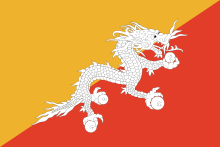
The flag of Bhutan (The Druk flag)
•Draco (the dragon) is the Latin name for a constellation in the Northern hemisphere. Some legends have it that because this constellation never sets (it's circumpolar like the Big Dipper) it is therefore ever vigilant and was considered a fiercely protective Goddess. There are many legends concerning Draco, but the one I like is the Greek legend where the dragon guarded the Golden Fleece, but alas, Jason slew him in order to possess the fleece and fulfill his quest. Draco also figured prominently in the 12 labors of Hercules where he slew the dragon with a poison arrow dipped in the blood of a hydra (see above) so that he could have access to one of the Golden Apples. Gold has always been a symbol for something very precious (see Colors on the Dream Dictionary page).
Interestingly enough the root word for Dragon in ancient Greek was Drakon that means "to see clearly" or "that which sees." This might be interpreted as wisdom.
The constellation Draco as depicted in Urania's Mirror (1825)
In Homer's Odyssey Jason searched for the Golden Fleece that was protected by the dragon that never sleeps (Drakon Kholkikos– a water serpent of huge size) . The fleece itself may have represented something of great value such as the King himself. The dragon was the beast that protected the source of power. In one version of this story the dragon swallows Jason, but later disgorges him (symbolizing the vomiting of inappropriate ideas and getting rid of them and thus releasing the Royal power of the gold back to the king). The idea of the fleece may have originated from the ancient Greek practice of using a lambs skin draped across a sluice box which would filter the gold in a river into the fleece and leaving behind a sheepskin full of gold.
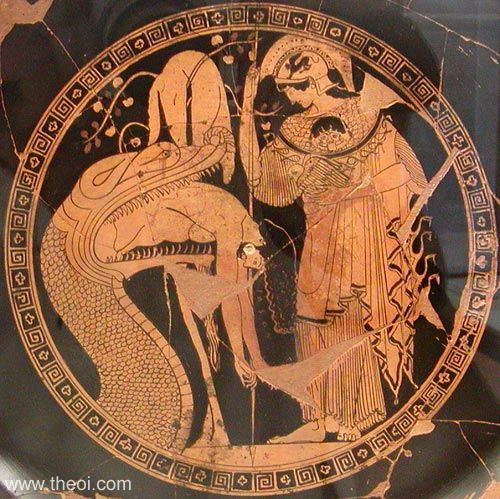
The dragon symbol shows up as one of the three beasts of the unholy trinity (the beast of the sea, the dragon, and the false prophet) of the Book of Revelations in the New Testament of the Christian Bible. Some modern day theorists see the dragon as a symbol for the military which protects the interest of the beast with no soul, or human values (it that rose up from the sea) i.e. the International Corporation (it's treated as a person legally, but isn't one in reality).
The third beast of this trinity is the false prophet that some liken to the priests of old who acted as though they were the messengers of God, but did only their earthly masters bidding. Some have even gone so far as to liken the Republican party of the U.S. to this 3rd member of the trinity.
Alexander the Great spoke of a 100 foot long dragon in his memoirs. His soldiers had seen the beast while campaigning in India sometime around 326 BCE.
There were also Dragoons who were both horsemen and infantry and named after the wide-mouthed musket they used that spat fire from its muzzle. The musket was named a Dragon gun. These were also carried by "Musketeers" during the 17th and 18th century.
 Musketeers with Dragon gun on single pole stand Musketeers with Dragon gun on single pole standIn Persia (modern day Iran) the word for Dragon is Aždarha– for this reason fossils of a pterosaur, an ancient flying animal with a wingspan stretching 30-40 feet and living near major lakes and rivers has been called AZHDARCHIDAN. It was believed that the baby of a dragon would be the same color as the mothers eyes. Most Persian dragons were malevolent in nature.
Dragons are to this day still being seen, for example on Feb 9, 2012 the following picture was taken in the skies over Fuzhao, China where observers swore they saw dragons flying overhead for several minutes.
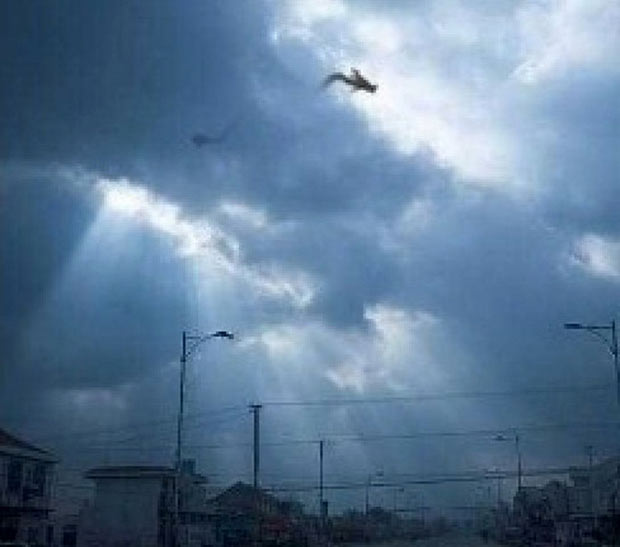
Herbal concoctions
Dragon's blood is a resin taken from a number of plants. It is also a poisonous resin from mercury sulfide, Cinnabar, that has been carved into boxes in both Japan and China.
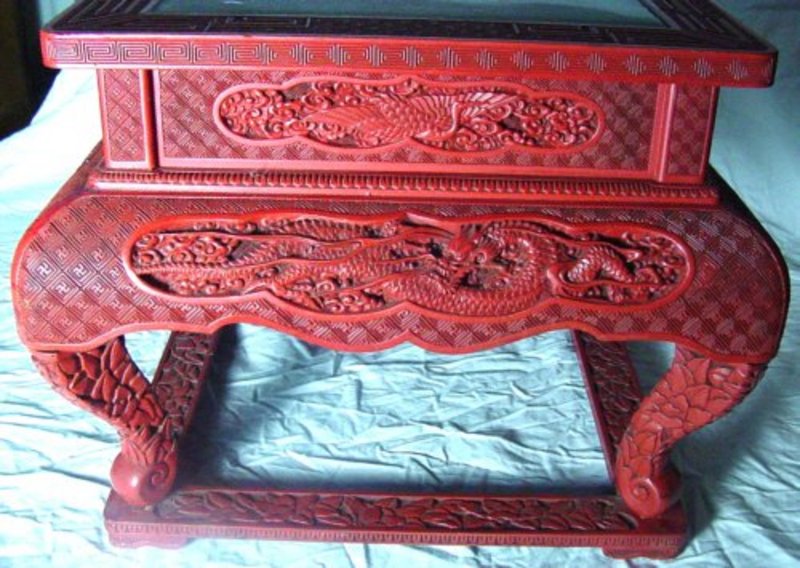
Many herbal concoctions having the name of the Dragon have been used for medicinal purposes, such as Dragon's Blood (a vitamin supplement) and dried Dragon Root (Green Dragon) that has been used for asthma and as a paste for sores and ringworm.
Two examples of a dragon dream image and interpretations:
#1 The Dream:
Name:
Email:
Comments: I was laying in bed trying to meditate and relax and when I woke I remebered seeing a shadowy shape slithering like a snake would, then later a I was sitting atop a red dragon asking myself "why is there a dragon here" ...... I felt compelled to get out of bed and write it down after I did so I felt a strange energy in my body and looked in the mirror and I swear I saw my skin moving like a wave of pulsating energy. when I woke up the next day I had no idea how to comprehend my experience. I hope you will be able to help me understand the meaning to it. Thank you
Interpretation:
The dragon within is a type of Yang, or masculine, energy. Often the dragon represents ones animal nature, the unconscious part. It can also symbolize aggression and other irrational forces of the unconscious. In this case it may be the dragon energy of passion and may lead you into trouble.
The dream might suggest that you need to moderate, or exercise some control over, your passions, your unconscious forces. You need to bring them to consciousness (get out of bed and ride them) before you can deal with them adequately. To keep them hidden allows them to control you instead of the other way around. In eastern cultures the dragon can be a protector and a spiritual symbol.
#2 The Dream:
Name:
Email:
Comments: I dreamt that I was in village with a family of my girl friend (she is only in the dream I don't know her) and there was always meals being served, but there was a mother and baby dragon flying around. They never seemed to harm anyone. The mother dragon was in valley and I went down to her, and climbed on her back and she flew up with me, I was hugging her with love and had no fear. It was very lucid and I have many flying dreams. That was just one part of it, there was a parked car that rolled into a wall and smashed and my girlfriend carried the car back ??? and I dreamt of a famous football player coming to visit with the possibility of playing for the local team, the village family head are very wealthy. (the footballer was Ronaldo in real Madrid uniform) . I live in South Africa.
Interpretation:
Dragons are often reflections of Yang energy, masculine energy, but yours is a female, with a nurturing energy. This might imply a need to balance the two energies within you, the yang and yin–the passion power of the masculine with the nurturing/protective power of the feminine. Climbing on her back may be about your needing to take greater control of your personal energies and of your life.
Food being served is also a nurturing symbol and a symbol for feeding something in ourselves i.e. nourishing the soul or spiritual side of ourselves.
Flying is most often a symbol of independence–a flying free of lifes limitations, or the limits imposed by yourself, or the need to be free of something.
Sometimes cars crashing can represent our own crashing of our lives sometimes deliberate so as to avoid some great stress, or some impending failure. You may actually be "hitting a wall" with your job, relationship, your life. It may be the hidden feminine part again that will help "pick up" the pieces so you can move past it.
The footballer may represent an aspect that you admire and want to incorporate into yourself. There may some wisdom in this (as symbolized by the village head).
“Always remember, it’s simply not an adventure worth telling if there aren’t any dragons.”
― Sarah Ban Breathnach
Women’s writer/author
Symbolic meaning of Serpents
•The Mayan, Azteca and other Mesoamerican cultures saw the "Feathered Serpent", or in some cases named Quetzacoatl, as both a god of knowledge, the embodiment of the sky, and the communicator with the underworld.
You can see the serpents visage at the bottom of the stairs at the Pyramid at Chichén Itzá, guarding this temple of the Mayan.
(Click here to enlarge)
•The Snake is very much akin to the Dragon. The name dragon was once defined as a great snake by the Greeks. In Old English the dragon was a Wyrm, meaning snake or serpent. To the European Celts and Australian Aborigine the snake was a creator being.The Greeks and Romans saw the snake as a being of healing, note that the Caduceus, the magic wand of Hermes, is the current symbol for the art and science of medicine. A snake biting its own tail is the Ouroboros, the symbol of the reconciliation of opposites in the vernacular of the Alchemists (lead into gold; something basal into something precious? Integrating Conscious (the world above) and unconscious (the world below), Yin and Yang, body and spirit) where we are constantly recreating ourselves. It is also the symbol for the cyclical nature of life—birth, death and rebirth. The notion of the dragon, or snake, eating its tail can be dated back to 1600 BCE in Egypt.
Ouroborus is also the symbol of time and the continuity of life—eternal unity. The symbol has shown up in the Mesolithic culture, the Gnostic text Pistis Sophia, The mystical text The Chrysopeia of Kleopatra, and in early Egyptian paintings. Carl Jung called it the Mandala of Alchemy in that it symbolizes the integration and assimilation of opposites as in our shadow. It also represents self-reflexivity and the eternal return and self-recreation (note the similarity with the Phoenix). It is the guardian of the mystical treasure symbolizing the sun. In Alchemy one needs to destroy the guardian (dragon) in order to know its treasure and to move on to another step in the process.
Note the Yin/Yang symbol and how it too could be related to this tail devouring dragon. As with the Hydra symbol (see above), Ouroboros could also represent something reoccurring, or revisiting and coming back, over and over again.
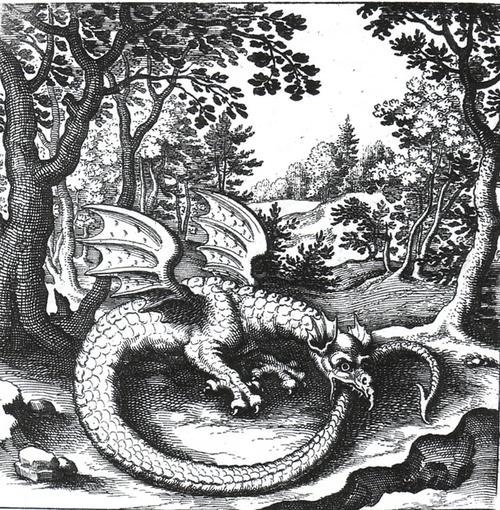
Ouroboros De Lapide Philosophico by Lucas Jennis(click here to enlarge)
According to Erich Neumann, a student of Carl Jung, the first state of psychological development is called the uroboric stage, derived from Ouroboros, the tail-eating serpent. At this stage is the initial totality and self-containment that occurs prior to the birth of consciousness. Here the ego exists only as a latent potentiality in a state of primary identity with the Self or the objective psyche. This state is presumed to exist within the prenatal period and into early infancy.
In the 2nd state the creation of the world for the individual psyche is formed. Here, the ego is born from the unconscious. As with all creation stories the basic theme is about separation i.e. that something separate comes out of the undifferentiated wholeness and becomes a separate being—ego (Note Adam and Eve, for example).
The Ouroboros was the most often used symbol in the work of the ancient alchemists. To them it represented the world-creating spirit that resides within matter. Many alchemists used it to represent Mercurius, or quicksilver, the prima materia of the alchemists work. It stands for the beginning and the end of the work i.e. the One that leads back to the One– the symbol of the union of opposites thus creating the whole. It can be imagined to represent the cold and fiery, matter and spirit, metallic and liquid, poison and healing drought.
He is also the Hermaphrodite of the Tarot, the coiniunctio of all opposites that makes up the world and the psyche of humankind. It appears as a symbol of the stone in the philosopher’s stone. It has been said that the work of the Alchemists was more than the experiments in chemistry ostensibly to discover both immortality and the process for making gold from lead but also a depiction of human psychology in all its mystery.
Similar symbols that suggest the same qualities would be the Zen symbol for unity 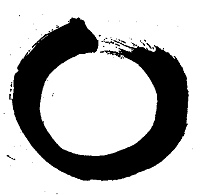 and the symbol for yin and yang and the symbol for yin and yang 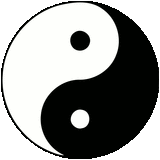 . .
Other meanings for the symbol of Ouroboros:
•What goes around, comes around (be careful what you put out in the world in that it can
come back and bite you.
•Revisiting something
•To find your self, look no further than yourself
•Look at something from another perspective
•Completion of something
•Completing the self by connecting mind and body, or head (thoughts) and body (feelings).
It would not be a stretch to see in the above the reconnection of the separate soul and ego as described by Jung in what he called the Individuation process, and the Native American vision of the dragon being a force of balancing as all suggesting the same healing of the separate parts, or the balancing of these parts. What caused the separation—the imbalance? What caused it, indeed. (this link will take you to the Spirit/Body page that explores the phenomena of separation.) reconnection of the separate soul and ego as described by Jung in what he called the Individuation process, and the Native American vision of the dragon being a force of balancing as all suggesting the same healing of the separate parts, or the balancing of these parts. What caused the separation—the imbalance? What caused it, indeed. (this link will take you to the Spirit/Body page that explores the phenomena of separation.)
• The Seraphim were described in the Hebrew bible by Enoch, grandfather of Noah, as Drakones, or flying serpents. Their job was to maintain the divinity in perfect order. Seraphim means "The Burning Ones". Later Christians morphed the Seraphim into human-like angels with six wings and relegated the serpent to a more basal position of deceit and the Dragon to symbolize Satan as a means of discrediting Pagan religions so as to reinforce the new religious world view.
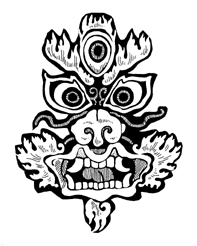
•The Nága are guardian serpents in the East. They were represented as hooded snakes and guarded the temple of Angkor Wat in Cambodia (Kampuchea). As with many symbols they have their positive and negative aspects in that the Nága can be both protective and destructive.
•Often snakes found underground and in the water (rivers, lakes and oceans) represent hidden emotions in dreams. In China people used to hide their money (treasure) underground so that it would be protected by the snakes. A snake in the water can be a strong emotion attacking you when you look too deeply into your unconscious.
•The people of the Zambezie Valley in Zimbabwe, Africa were protected by a river snake, Nayaminyami. It was the ruler of the sacred water and his symbol is still worn to protect against the forces of darkness and attracting the forces of good fortune.

A Nyaminyami walking stick
• In ancient Thebes Drakon Ismenios was a gigantic serpent which guarded the sacred spring of Ismenos.
•In Greek mythology the Medussa, (see Carvaggio painting at right) the prettiest of three Gorgon sisters who's hair was made of writhing snakes and who's eyes could turn you to stone if you looked at them has a number of symbolic meanings. To be turned to stone might indicate becoming incapacitated or rigid in thinking, deed or response.
Another interpretation might see this visage as a
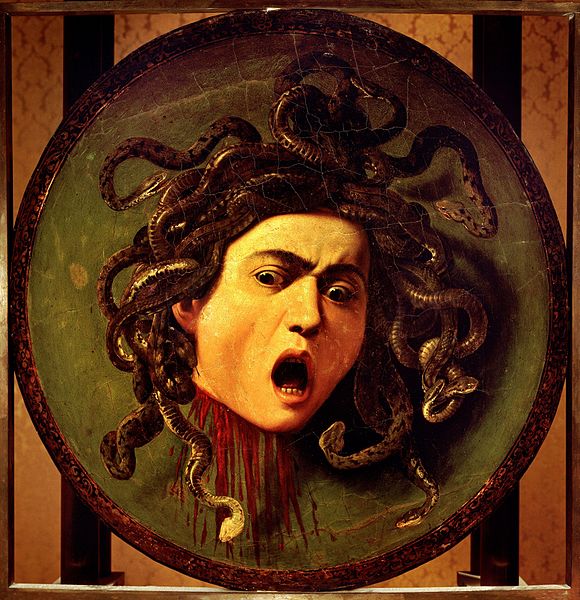 dangerous seductive force in your life (look to see what it might be referring to in the dream), or a controlling, subversive femine power. Ellen Reeder in her book Pandora:Women in Classical Greece (1996) suggested that it could represent the male fear of devouring female sexuality. dangerous seductive force in your life (look to see what it might be referring to in the dream), or a controlling, subversive femine power. Ellen Reeder in her book Pandora:Women in Classical Greece (1996) suggested that it could represent the male fear of devouring female sexuality.
Drakon was the Greek name for serpent and figured as the Overlord of the many horned animals of the Book of Revelation in the Christian Bible.
The snake is the "Mother of all Gods" in Greek mythology.
The ancient Greek god Asklepios, originally a mortal healer, would appear to the practitioners of his medical arts as a snake. The healer-god Amphiaraos would become a snake who would lick and suck the poison from the bodies of those who came to the dream clinic to be healed. For this reason snakes were allowed to run freely through the dream incubation centers called the Asklepion. (See the History of Dreams for more on these centers)
•In Alchemy the, quadricornutus serpens (four horned serpent) was a symbol for the liquid metal Mercury.
•In Hindu mythology the serpent Karkotaka denotes eternal wisdom. Snakes are considered to be long-lived, or even immortal) because they continuously renew themselves by shedding their skins. In Hindu belief, Vishnu used a snake to churn the ocean. Nag is the king of snakes in the hindu tradition. It is a female deity in India and called "the Mother of all that moves."
In both Hinduism and Buddhism Tantric sages consider the her (the snake) the inner power of the Kundalini and what they try to awaken through their meditations.
•There's another Hindu myth regarding the young god Krishna who one day is walking through the forest with some sheep herders and is swallowed by a giant serpent demon named Ugrasura. Krishna grows to such a height that he burst opens the snake and all are freed. Because all human myths reflect some part of the psyche of human beings I cannot help but think that this encounter symbolizes the great danger of unrecognized subconcious material (often symbolized by dark forests and demon snakes) that threatens to consume all human beings until they become big enough to confront and deal with it (see St George and the Dragon above).
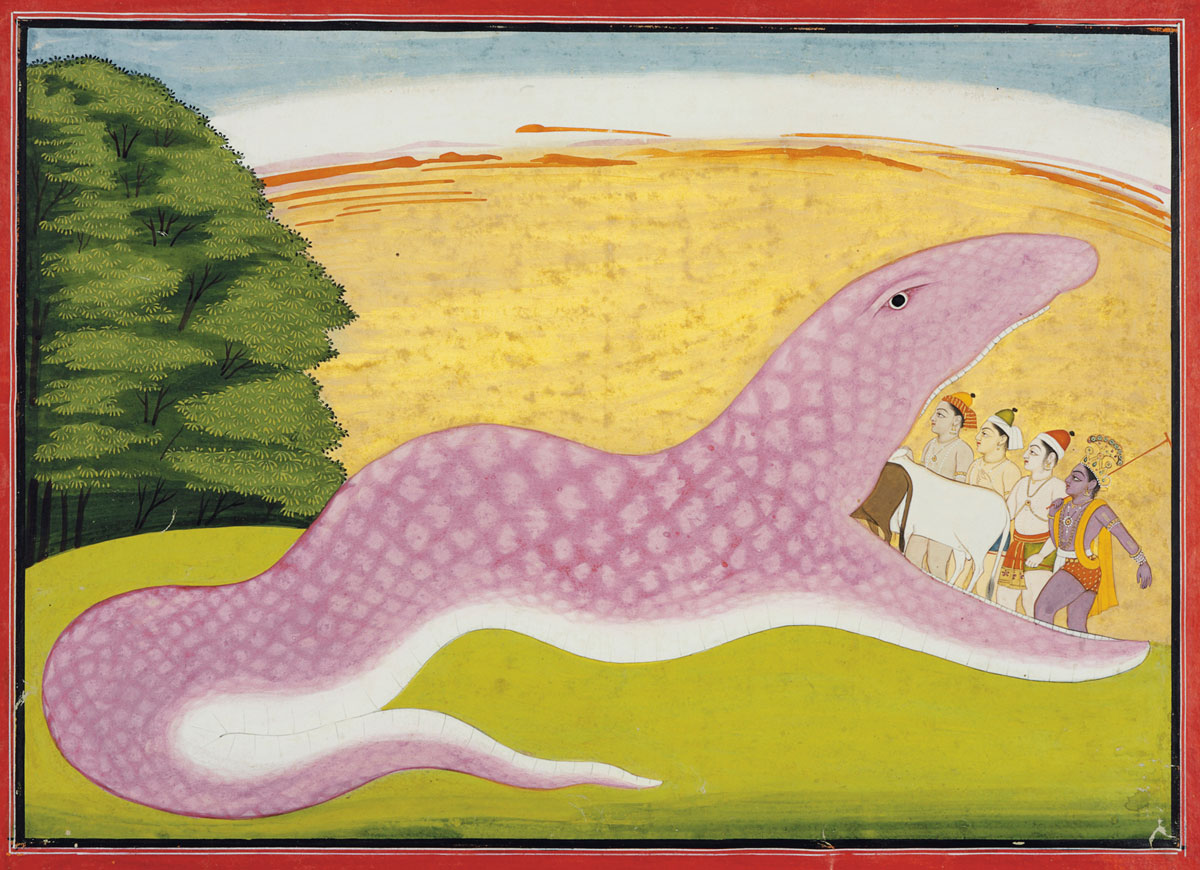
Ugrasura (Krishna on the right)
•Even though in some Judeo-Christian societies the snake is seen as a negative and decietful influence, it was also depicted in a more favorable light. Moses transformed his staff with God's help into a snake in order to persuade Pharoah to let the Israelite go free and in Mathew 10:16 Jesus was reported to have said "Be ye therefore wise as serpents, and harmless as doves." Once again one needs to use the symbolism that resonates with them personally.
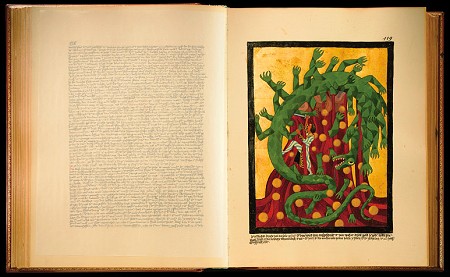
Jung's drawing of a dream dragon from his Red Book: Liber Novus. Ed. By Sonu Shamdasani, 2009
Other dragon-like creatures include:
• The Griffin (a guardian creature as well)
• A Basilisk (its gaze can be fatal as can the serpent haired Gorgon, Medussa)
• A Persian Simurgh (associated with magical healing and the union of heaven and earth)
•As a dream creature the snake can represent temptor, or healer. It can also represent someone lowly and if it bites, it can represent criticism either from without, or from within (as in self-criticism).
Caveat
Though I have spent a great deal of time listing and exploring in depth the meaning of the Dragon in dreams and myth, I have only scratched the surface of what this image has to offer the dreamer.
As with all creatures and objects in a dream they have an imaginal life of their own. To treat them as two-dimensional symbols so as to do forensics on them may mean that you miss out on most of what they have to offer.
In a dream work technique called Dream Tending, offered by Dr. Stephen Aizenstat of the Pacific Graduate Institute in Santa Barbara, Ca, these images can be animated by the dreamer and worked in depth within the present time. The idea, in general, is to keep the image alive and to let it continue to provide real time information to the dreamer. In this way the Dragon image when it visits a dream, or even if it visits during the waking work with a dream, can continue to inform way beyond the initial analysis of the dream's symbolic imagery.
Should you want to explore this technique, I've included the following link to the Dream Tending book at Amazon.com:
http://www.amazon.com/s/ref=nb_sb_noss?url=search-alias%3Dstripbooks&field-keywords=Dream+Tending+by+Aizenstst&x=13&y=20
***
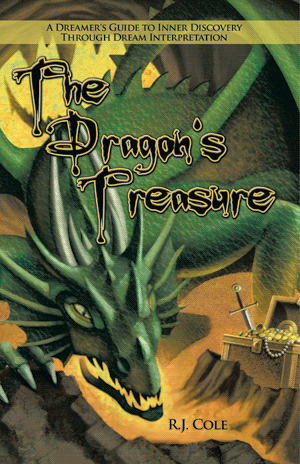
If you want to know more about the meaning of your dreams and how the symbols play across the story of your life, buy the book The Dragon's Treasure.  (click on the parchment to portal-jump to the Book Purchase page) (click on the parchment to portal-jump to the Book Purchase page)
|